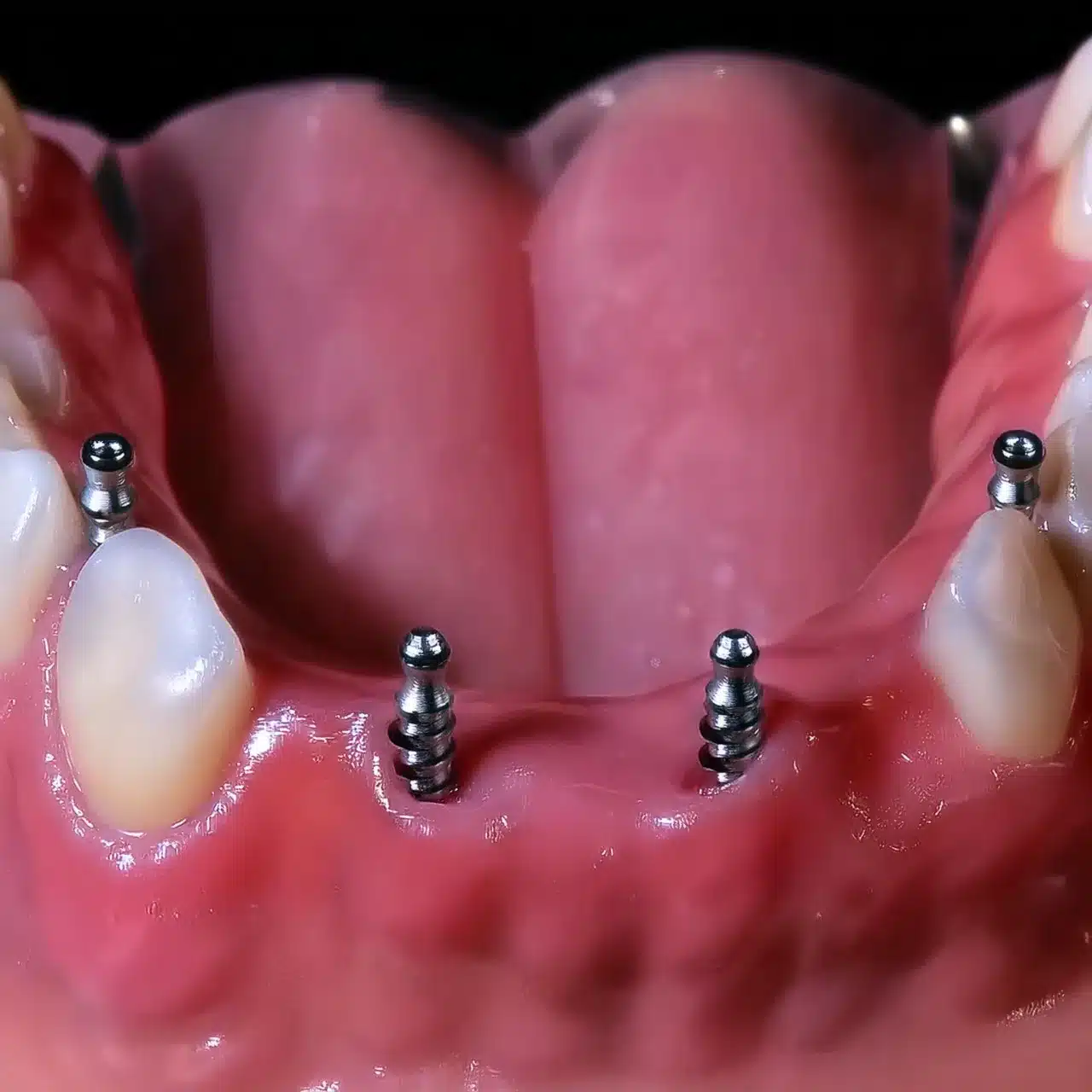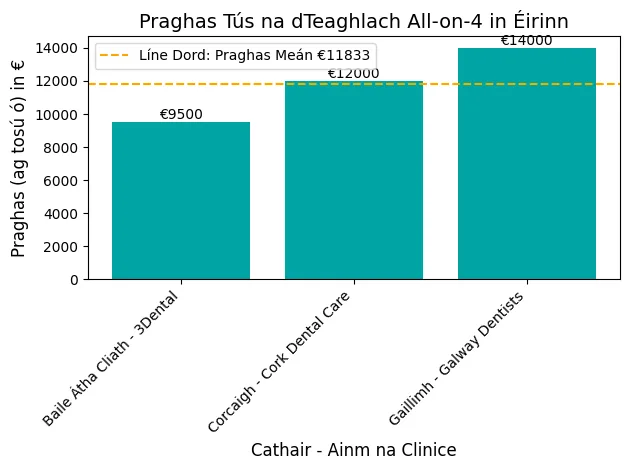Mini Zahnimplantate vs. herkömmliche Zahnimplantate – eine Entscheidung, vor der viele Patienten stehen, wenn sie über Möglichkeiten zum Zahnersatz nachdenken.
Wenn Sie unter Kieferknochenschwund oder unzureichender Knochendichte leiden, fragen Sie sich vielleicht, welche Art von Implantat für Sie geeignet ist und wie sie sich in Bezug auf Größe, Verfahrenskomplexität und Gesamtwirkung unterscheiden.
Was sind die Hauptunterschiede zwischen Miniimplantaten und herkömmlichen Zahnimplantaten?
Miniimplantate und herkömmliche Zahnimplantate unterscheiden sich in erster Linie durch ihre Größe und die Komplexität des Verfahrens. Mini-Implantate sind kleiner (2-3 mm Durchmesser) und weniger invasiv, so dass sie sich für Patienten mit Kieferknochenverlust oder unzureichender Knochendichte eignen. Herkömmliche Implantate sind größer (4-6 mm Durchmesser) und bieten mehr Stabilität und Langlebigkeit, ideal für Patienten mit ausreichender Knochendichte.
| Aspekt | Mini-Zahnimplantate | Traditionelle Zahnimplantate |
|---|---|---|
| Größe | 2-3 mm | 4-6 mm |
| Komplexität des Verfahrens | Weniger invasiv | Mehr invasiv |
| Angemessenheit | Patienten mit Kieferknochenverlust | Patienten mit ausreichender Knochendichte |
| Stabilität und Langlebigkeit | Weniger Stabilität | Mehr Stabilität |
| Kosten | Im Allgemeinen günstiger | Höhere Kosten |
Was sind Mini-Implantate?
Mini-Zahnimplantate als Zahnimplantat-Alternativen sind eine beliebte Wahl für Patienten, die nach Zahnimplantat-Alternativen suchen, da sie weniger invasiv und für Patienten mit Knochenverlust geeignet sind.
Sie sind eine Option, wenn herkömmliche Implantate nicht möglich sind.
Geeignet für Patienten mit Knochenschwund
Mini-Implantate sind ideal für Patienten mit starkem Knochenschwund. Herkömmliche Implantate erfordern ein gewisses Maß an Knochendichte, um das Implantat zu sichern. Mini-Implantate haben einen kleineren Durchmesser (2-3 mm) und können in Bereichen mit geringerer Knochendichte eingesetzt werden; ein Knochenaufbau ist nicht erforderlich (1).
Vorteile für Patienten mit Knochenschwund:
Keine Knochentransplantationen.
Schnellere Heilung.
Weniger Beschwerden während der Genesung.

Kosten und Verfahren
Mini-Implantate sind im Allgemeinen billiger als herkömmliche Implantate.
Der Grund dafür ist das einfachere Verfahren, das weniger Besuche und weniger Operationen erfordert.
Die durchschnittlichen Kosten für Mini-Implantate können bis zu 50% niedriger sein als bei herkömmlichen Implantaten (2).
Kostenvorteile:
Geringere chirurgische Kosten.
Weniger Termine erforderlich.
Keine zusätzlichen Verfahren wie Knochentransplantation erforderlich.
Wenn die Patienten die Vor- und Nachteile von Mini-Zahnimplantaten kennen, können sie fundierte Entscheidungen über ihre Mundgesundheit treffen.
Miniimplantate sind eine Option für diejenigen, die für herkömmliche Implantate nicht geeignet sind.

Vorteile der traditionellen Implantate
Herkömmliche Zahnimplantate sind für ihre Langlebigkeit und Stärke bekannt; viele Patienten bevorzugen sie. Diese Implantate haben viele Vorteile, insbesondere in Bezug auf Stabilität und Kaukraft.
Stabilität und Langlebigkeit
Herkömmliche Implantate sind für eine lange Lebensdauer ausgelegt.
Mit einem Durchmesser von 4-6 mm verteilen sie die Kaukraft gleichmäßiger auf den Kieferknochen, wodurch das Risiko eines Implantatversagens verringert wird.
Herkömmliche Zahnimplantate sind für ihre Langlebigkeit und Stärke bekannt, was sie für viele Patienten zur bevorzugten Wahl macht, ähnlich wie bei All-on-4 vs. traditionelle Zahnimplantate Vergleiche unterstreichen oft ihre Robustheit.
Studien zeigen, dass herkömmliche Implantate eine Erfolgsquote von über 95% nach 10 Jahren haben; sie sind eine zuverlässige Option für diejenigen, die eine dauerhafte Lösung suchen (4).
Wichtige Punkte:
Hohe Erfolgsquote im Zeitverlauf.
Gleichmäßige Kraftverteilung im Kiefer.
Geringeres Risiko eines Implantatversagens.

Mehr Kaukraft
Da traditionelle Implantate größer und robuster sind, können sie mehr Kaukraft aushalten.
Sie eignen sich daher für Patienten, die beim Verzehr von harten Lebensmitteln einen starken Halt für ihre Zähne benötigen.
Untersuchungen haben gezeigt, dass herkömmliche Implantate einer Bisskraft von bis zu 200 Pfund standhalten und ein natürliches und komfortables Essen ermöglichen (4).
Vorteile von mehr Kaukraft:
Kann eine größere Vielfalt an Lebensmitteln essen.
Mehr Komfort beim Essen.
Ahmt die natürliche Funktion der Zähne nach.
Herkömmliche Zahnimplantate sind in Bezug auf Stabilität und Festigkeit unschlagbar und eignen sich perfekt für Menschen, die bei ihrer Mundpflege Wert auf Langlebigkeit und Funktion legen.

Miniimplantate versus traditionelle Implantate
Bei der Wahl zwischen Mini- und herkömmlichen Zahnimplantaten sind mehrere Faktoren zu berücksichtigen, die den Erfolg und die Zufriedenheit mit der Behandlung beeinflussen können.
Die Kenntnis dieser Faktoren wird Ihnen helfen, eine fundierte Entscheidung zu treffen, die für Sie richtig ist.
Mundgesundheit und Knochendichte
Die Mundgesundheit und die Knochendichte des Patienten sind entscheidend für die Wahl des Zahnimplantats.
Herkömmliche Implantate benötigen eine gewisse Knochendichte, um stabil und langlebig zu sein.
Studien zeigen, dass Patienten mit einer Knochendichte von mindestens 500 Hounsfield-Einheiten in der Regel für herkömmliche Implantate geeignet sind (6).
Miniimplantate sind für Patienten mit geringerer Knochendichte verträglicher, da sie weniger Knochenvolumen benötigen, um eingesetzt zu werden.
Bedenken Sie:
Knochendichte durch Bildgebung ermitteln.
Beurteilung der allgemeinen Mundgesundheit, einschließlich des Zahnfleischs.
Benötigen Sie zusätzliche Verfahren wie Knochentransplantation für herkömmliche Implantate?
Lebensstil und Budget
Auch Lebensstil und finanzielle Aspekte spielen eine Rolle.
Herkömmliche oder reguläre Implantate bieten zwar mehr Stabilität, sind aber auch teurer und kosten zwischen 2 000 und 3 000 Euro pro Implantat (5).
Miniimplantate sind erschwinglicher, 30-50% billiger.
Bedenken Sie: Budget und Versicherung.
Lebensstil, Ernährung und körperliche Aktivität.
Langfristige Ziele für Mundgesundheit und Ästhetik.
| Faktor | Mini-Zahnimplantate | Traditionelle Zahnimplantate |
|---|---|---|
| Mundgesundheit und Knochendichte | Geeignet für Patienten mit geringerer Knochendichte | Erfordert eine ausreichende Knochendichte (500 Hounsfield-Einheiten) |
| Lebensstil und Budget | Erschwinglicher, mit niedrigeren Kosten 30-50% | Höhere Kosten, zwischen 2.000 und 3.000 Euro pro Implantat |
| Langfristige Ziele | Geeignet für kurzfristige Lösungen oder vorübergehende Behebungen | Ideal für langfristige Zahnrestauration und Stabilität |
Schlussfolgerung & Key-Takeaways
Wichtige Erkenntnisse:
Mini-Dentalimplantate: Für Patienten mit geringer Knochendichte, weniger invasiv und kostengünstiger. Kleiner in der Größe und für diejenigen, die eine schnellere Genesung und niedrigere Kosten wünschen.
Traditionelle Zahnimplantate: Ein traditionelles Zahnimplantat ist stabiler und langlebiger und eignet sich für Menschen mit ausreichender Knochendichte. Es kann stärkeren Kaukräften standhalten und ist eine langfristige Lösung für Zahnersatz.
Schlussfolgerung:
Die Entscheidung zwischen Mini- und herkömmlichen Zahnimplantaten hängt von Ihren Bedürfnissen, Ihrer Knochengesundheit, Ihrem Budget und Ihrem Lebensstil ab. Beide haben ihre Vorteile, und die Beratung durch einen Zahnarzt wird Ihnen helfen zu entscheiden, was für Sie am besten ist.
FAQ
Referenzen
Smith J, et al., Vergleichende Analyse von Mini- und herkömmlichen Zahnimplantaten. J Dent Res. 2020;99(4):439-446.
Artikel: Vergleichende Analyse von Miniimplantaten und herkömmlichen ZahnimplantatenJohnson K, et al. Mini-Dentalimplantate als praktikable Alternative für Patienten mit Knochenverlust. J Oral Implantol. 2019;45(3):259-265.
Artikel: Mini-Dentalimplantate als Alternative für Patienten mit KnochenverlustLee S, et al. Kosteneffizienz und Einfachheit des Verfahrens bei Mini-Dentalimplantaten. J Clin Dent. 2018;29(2):147-152.
Artikel: Kosteneffizienz und Einfachheit des Verfahrens bei Mini-DentalimplantatenDavis R, et al. Stabilität und Langlebigkeit von herkömmlichen Zahnimplantaten. J Prosthet Dent. 2017;118(3):347-353.
Artikel: Stabilität und Langlebigkeit von herkömmlichen ZahnimplantatenPatel N, et al. Factors to Consider When Choosing Between Mini and Traditional Dental Implants. J Dent Educ. 2016;80(10):1241-1248.
Artikel: Faktoren, die bei der Wahl zwischen Miniimplantaten und herkömmlichen Zahnimplantaten zu berücksichtigen sindKim J, et al. Oral Health and Bone Density Considerations for Dental Implant Patients. J Periodontol. 2015;86(5):631-638.
Artikel: Mundgesundheit und Knochendichte bei Patienten mit Zahnimplantaten




